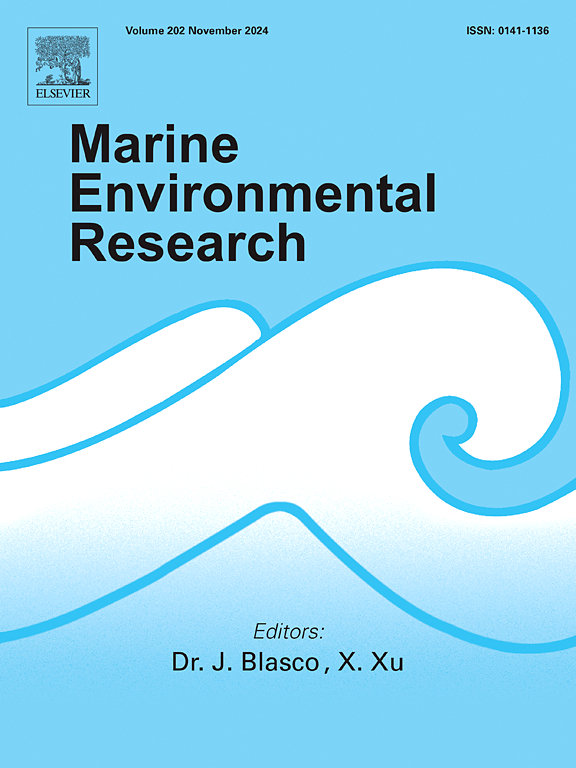Ecological responses of benthic foraminifera to trace element pollution in the Beypore estuary, Southwest coast of India: Implications for coastal anthropogenic contamination
IF 3
3区 环境科学与生态学
Q2 ENVIRONMENTAL SCIENCES
引用次数: 0
Abstract
To investigate the sediment composition, pollution levels, and ecological health of the Beypore estuary in Kerala, Southwest coast of India, a comprehensive analysis was conducted. This area had previously experienced pollution from the Rayon factory, which was closed due to widespread opposition from both the government and the public. The study involved the collection and analysis of 12 shallow sediment samples, focusing on sediment characteristics, trace metal concentrations, and benthic foraminiferal responses. The findings were compared with previous results from 11 overlapping and nearby stations collected in 1989 and published in 2002. Notable changes over three decades (1989–2015) revealed a shift from sandy sediments upstream to clay rich sediments downstream, reflecting complex sediment transport dynamics influenced by varying hydrodynamic conditions and an inverse sand-silt relationship. Trace metal analysis showed significant variability across the study area, with elevated concentrations of Cr, Zn, Ni, Cu, Pb, and Mn. The Igeo and PLI indicated moderate to strong pollution levels for Pb in upstream regions, associated to anthropogenic activities such as industrial and urban runoff. Bioaccumulation analysis of Ammonia parkinsoniana and A. tepida highlighted the impact of environmental stressors, helping to clarify the association between sediment quality and foraminiferal ecology. PCA of the foraminiferal test compositions revealed distinct patterns corresponding to environmental conditions and sedimentary influences. The previous study in 2002 found that trace element concentrations in the estuary were much lower than average shale values. However, the increased levels of certain elements were likely due to residual contamination from past discharges by the Rayon factory which was not operational at that time. The current study observed an increase in the average concentrations of trace elements such as Zn, Ni, Cu, and Pb. The presence of elements like Fe, Cr, and S in benthic foraminiferal tests suggests the influence of additional regional pollution sources. The PERMANOVA results show the statistical significance and interactions between sediment characteristics, geochemical factors and benthic foraminiferal responses, emphasizing the intricate relationships among these variables with trace elements serving as important bioindicators of environmental changes in estuarine and coastal ecosystems. Finally, this study suggests the critical need for stronger management strategies, including stricter regulations on industrial discharges, improved waste management practices, and habitat restoration efforts to promote biodiversity and ecosystem resilience. Continued research is essential for monitoring long-term trends in trace metal concentrations and sediment characteristics, offering crucial data to inform policy decisions that safeguard estuarine ecosystems and promote sustainable development.
求助全文
约1分钟内获得全文
求助全文
来源期刊

Marine environmental research
环境科学-毒理学
CiteScore
5.90
自引率
3.00%
发文量
217
审稿时长
46 days
期刊介绍:
Marine Environmental Research publishes original research papers on chemical, physical, and biological interactions in the oceans and coastal waters. The journal serves as a forum for new information on biology, chemistry, and toxicology and syntheses that advance understanding of marine environmental processes.
Submission of multidisciplinary studies is encouraged. Studies that utilize experimental approaches to clarify the roles of anthropogenic and natural causes of changes in marine ecosystems are especially welcome, as are those studies that represent new developments of a theoretical or conceptual aspect of marine science. All papers published in this journal are reviewed by qualified peers prior to acceptance and publication. Examples of topics considered to be appropriate for the journal include, but are not limited to, the following:
– The extent, persistence, and consequences of change and the recovery from such change in natural marine systems
– The biochemical, physiological, and ecological consequences of contaminants to marine organisms and ecosystems
– The biogeochemistry of naturally occurring and anthropogenic substances
– Models that describe and predict the above processes
– Monitoring studies, to the extent that their results provide new information on functional processes
– Methodological papers describing improved quantitative techniques for the marine sciences.
 求助内容:
求助内容: 应助结果提醒方式:
应助结果提醒方式:


